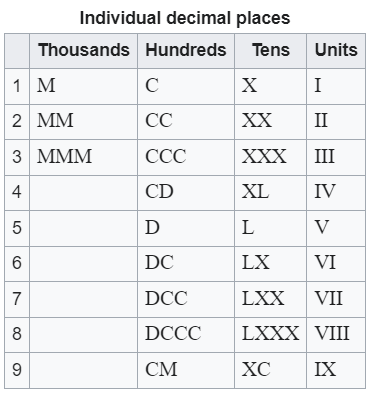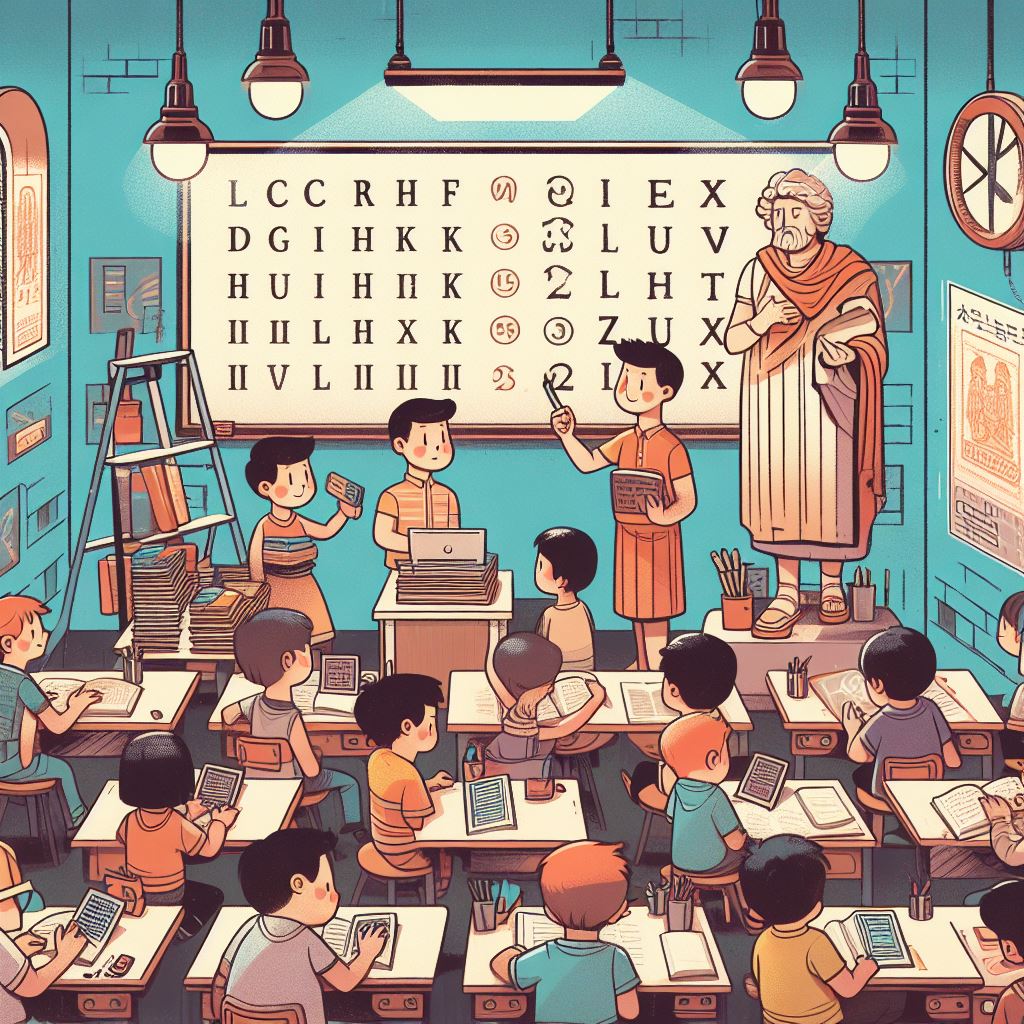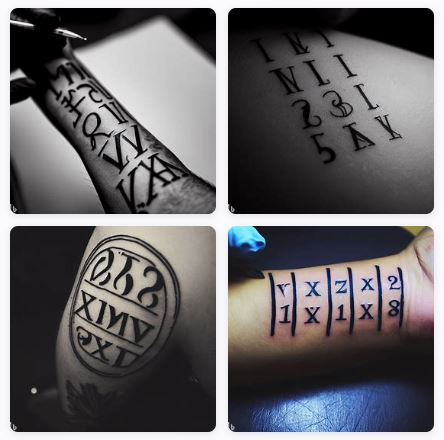Live Date and Time
Roman Numerals:
Numeric:
Unraveling the Mystery of Roman Numerals
Have you ever wondered how ancient civilizations communicated using numbers before the Arabic numeral system became ubiquitous?
Enter Roman numerals, a captivating numerical notation system that has withstood the test of time.
Roman Numerals 1- 24
Looking for your basic Conversion?
Decimal to Roman Numeral Converter
Roman Numeral:

A journey through the history, intricacies, and practical uses of Roman numerals. Whether you’re a history buff or simply curious, this will demystify Roman numerals and provide you with a newfound appreciation for their enduring legacy.
The Birth of Roman Numerals
The enigmatic tapestry of Roman numerals, woven into the rich historical fabric of ancient Rome, is a tale that intertwines the grandeur of architectural marvels, the intricacies of governance, and the strides in mathematical prowess that this civilization is renowned for.
In Rome’s nascent stages, its inhabitants relied on the primal method of counting, using their fingers, mirroring our own contemporary practices. Yet, as the Roman societal structure evolved, growing in complexity and sophistication, there emerged a pressing need for a more advanced numerical system.
This quest for numerical refinement led the Romans to the doorstep of the Etruscans. Living adjacent to Rome, the Etruscans had devised their own rudimentary numerical system, employing a combination of horizontal lines and dots to signify numbers.
It was from this Etruscan foundation that the Romans drew inspiration, meticulously honing and expanding upon it. Through this process of adoption and enhancement, they eventually birthed the set of symbols now universally recognized as Roman numerals. This evolution not only reflects the adaptability of the Romans but also serves as a testament to their enduring legacy in the tapestry of human history.
Evolution of Roman Numerals in Ancient Rome
The genesis and maturation of the Roman numeral system was not an abrupt phenomenon; rather, it was a gradual evolution, unfolding over many centuries. In its embryonic stage, this system was remarkably straightforward, anchored by a mere trio of symbols: I, representing 1; X, signifying 10; and C, denoting 100.
These symbols found utility in a myriad of realms – from the bustling arenas of trade to the meticulous tasks of record-keeping, and even in the solemn inscriptions of official documents.
As the Roman Empire’s borders stretched, encompassing a vast and varied tapestry of lands and cultures, its internal complexities burgeoned. It was in this milieu of expansion and sophistication that the Romans recognized an imperative need: a numeral system with greater versatility.
In response to this necessity, they ingeniously augmented their numerical lexicon, introducing symbols such as V (5) and L (50). This strategic expansion of symbols significantly enhanced the system’s efficiency, especially in representing larger numbers. It was a pivotal shift, reflecting the adaptive ingenuity of the Romans in the face of their empire’s ever-evolving demands.
The Basic Symbols and Their Values: I, V, X, L, C, D, and M
Roman numerals are composed of seven fundamental symbols, each representing a specific numerical value:
- I – Represents the number 1.
- V – Represents the number 5.
- X – Represents the number 10.
- L – Represents the number 50.
- C – Represents the number 100.
- D – Represents the number 500.
- M – Represents the number 1000.
These symbols are the building blocks of Roman numerals, and by combining them in various ways, you can represent a wide range of numbers.
Rules for Forming Numbers in Roman Numerals
To create valid Roman numerals, it’s essential to follow some fundamental rules:

Addition Rule: You can add Roman numerals together to form larger numbers. For example, II is 1 + 1, which equals 2.
Subtraction Rule: To avoid repeating the same symbol more than three times in a row, a smaller numeral in front of a larger numeral indicates subtraction. For instance, IV represents 5 – 1, resulting in 4. Similarly, IX represents 10 – 1, resulting in 9.
Repetition Rule: Roman numerals can be repeated up to three times in succession. Beyond that, you must use subtraction. For example, III is 1 + 1 + 1 (valid), but IIV is not allowed.
No Zero: Roman numerals do not have a symbol for zero. They start with I (1) and increase from there.
Examples of How to Represent Numbers Using Roman Numerals
Let’s explore some examples to illustrate how Roman numerals work:
- The number 3 is represented as III (I + I + I).
- The number 7 is represented as VII (V + I + I).
- The number 9 is represented as IX (X – I).
- The number 42 is represented as XLII (L – X + I + I).
- The number 99 is represented as XCIX (C – X + I – I).
- The number 149 is represented as CXLIX (C – X + L + I).
- The number 2022 is represented as MMXXII (M + M + X + X + I + I).
- The number 3999 is represented as MMMCMXCIX (M + M + M + C + M + X + C + I + X).
These examples demonstrate the versatility of Roman numerals, allowing for the representation of a wide range of numbers with a concise set of symbols.
By mastering the rules and principles of Roman numerals, you can decipher and create numbers in this ancient numerical notation system.
Strategies for Forming Larger Numbers and Avoiding Repetition:
As we delve into the world of Roman numerals, you’ll discover that expressing larger numbers efficiently is crucial. To do this, you can employ several strategies:
Concatenation: One simple strategy is to concatenate (join together) the symbols for smaller numbers to represent larger ones. For instance, to express 30, you can write XXX (X + X + X), and for 300, it’s CCC (C + C + C).
Place Value: Roman numerals are similar to our decimal system. By understanding the place value of each symbol, you can construct larger numbers. For example, to represent 70, you can write LXX (L + X + X + X).
Subtractive Notation: This strategy involves subtracting a smaller value from a larger one. For instance, to represent 4, you write IV (5 – 1), and for 9, you use IX (10 – 1).
Combining Additive and Subtractive: You can combine addition and subtraction to express numbers efficiently.
For example, to represent 49, you write XLIX (50 – 10 + 1 – 1).
Subtracting Values in Roman Numerals:
Subtracting values in Roman numerals is a fundamental concept that allows for more concise representations. Here are some common examples:
IV represents 4 (5 – 1).
IX represents 9 (10 – 1).
XL represents 40 (50 – 10).
XC represents 90 (100 – 10).
CD represents 400 (500 – 100).
CM represents 900 (1000 – 100).
By subtracting smaller values from larger ones, the Romans could efficiently express numbers without using too many symbols.
Roman Numeral Practice Exercises:
Let’s test your knowledge of Roman numerals with some practice exercises:
Roman Numeral Quiz
By working through these exercises, you'll reinforce your understanding of Roman numerals and improve your skills in both reading and writing them.
Remember to check your answers for accuracy to master this ancient numerical system.
Where You Can Still Find Roman Numerals Today:
The Timeless Legacy of Roman Numerals
In a world driven by digits and decimals, there exists a timeless numerical system that continues to weave its elegant presence into various aspects of our modern lives—the Roman numerals.
These graceful symbols, dating back to ancient Rome, are more than just a relic of the past. They endure, making their mark in the most unexpected places.
Clock Faces: A Journey Through Time
Picture yourself standing before a grand antique clock, its face adorned with Roman numerals. You're not just witnessing time; you're experiencing history. Roman numerals on clock faces have a storied tradition, harking back to the Roman Empire. The simplicity and charm of these symbols have transcended centuries, adorning both classic analog timepieces and decorative clocks today.
Click the image to get this clock.
Jewelry: A Touch of Elegance
Imagine receiving a gift, and unwrapping it to reveal a bracelet or necklace. Intricate Roman numerals etched into the metal give it an air of sophistication.
Roman numerals in jewelry designs add a touch of elegance, making them perfect for any special occasion.
Monuments and Buildings: Markers of History
As you meander through the city's vibrant streets, your journey is punctuated by the sight of a magnificent monument. Standing tall, its grandeur is etched in stone, a silent sentinel to the passage of time. The inscriptions adorning it are not just mere markings; they are the echoes of history, a testament to the epochs that have come and gone.
Prominently featured among these are the Roman numerals, those iconic symbols that have transcended mere numerical representation to become emblems of a bygone era. They are a homage to the classical architecture and the rich cultural heritage that Rome bestowed upon the world.
This influence is not confined to the past; it reverberates through the ages, shaping architectural styles across the globe, a timeless tribute to Rome's enduring legacy.
The Classroom Chronicles: Teaching Roman Numerals

Now, let's step into the classroom, where the legacy of Roman numerals is passed down to the next generation.
Students in elementary and middle school embark on a journey of discovery. They learn not just the symbols—I, V, X, L, C, D, and M—but also the fascinating stories behind them.
The classroom is alive with activity as students engage in hands-on learning. They practice forming numbers using Roman numerals, explore the rules of combination and subtraction, and delve into the real-world applications of these ancient symbols.
Cultural and Historical Context: Lessons Beyond Numbers
The educators go beyond the numbers; they dive into the rich cultural and historical context of Roman numerals.
They share tales of clock faces, historical documents, and architectural landmarks, instilling a sense of wonder and appreciation for this enduring legacy.
The Fascinating Tidbits: Secrets of Roman Numerals
Did you know that Roman numerals have a history that predates ancient Rome?
They evolved from the Etruscan numeral system before becoming an integral part of Roman culture. Yet, they lack a symbol for zero, a fact that makes complex calculations a challenge, ultimately leading to the adoption of Arabic numerals.
Prominent Displays: Where Roman Numerals Shine
As we journey further, we encounter Roman numerals in prominent displays worldwide. The iconic "Hollywood" sign, with its hidden years represented in Roman numerals, stands tall in Los Angeles.
Clock towers like Big Ben in London and the Colgate Clock in New Jersey grace our cities, their faces adorned with these enduring symbols. Historical monuments, such as the Arc de Triomphe in Paris and the Washington Monument in Washington, D.C., bear Roman numerals to mark their significant dates and events.
Unusual Challenges: Deciphering the Quirks
But Roman numerals are not without their quirks.
Representing large numbers can be a delightful puzzle, as "MCMLXXXVIII" elegantly signifies the year 1988. Complex subtractions, such as MCMXCIX for 1999, offer a glimpse into the ancient art of mathematical notation.
The Modern Adventure: Roman Numerals in Entertainment
Our journey takes a modern twist as we explore the world of entertainment. In the credits of movies, TV shows, and video games, Roman numerals continue to captivate viewers.
These annual copyright dates, presented in Roman numerals, offer a delightful challenge for those curious enough to decipher them.
Roman Numerals in Pop Culture
The influence of Roman numerals in contemporary pop culture is both profound and pervasive, extending its reach into various realms of entertainment. These ancient symbols, steeped in history, have seamlessly woven themselves into the fabric of modern storytelling and visual arts.
In the world of cinema, Roman numerals often grace the silver screen, adding a touch of classical elegance to movie titles, particularly in sequels. They serve not only as a chronological marker but also as a stylistic element, evoking a sense of timelessness and grandeur.
Television shows, too, have embraced these numerals, using them to denote seasons and episodes. This usage imparts an air of sophistication and continuity, subtly linking the modern episodic narratives to the epic sagas of ancient times.
Video games, a relatively newer form of entertainment, have also adopted Roman numerals. They are frequently used in game titles, especially in series, lending an aura of epic scale and historical depth. In gameplay, these numerals can often be found as part of the game's interface or in puzzle elements, challenging players to decipher them as part of their immersive experience.
Through these varied appearances, Roman numerals have not only endured but also thrived in modern culture, bridging the ancient and the contemporary in unique and creative ways.

Movie Sequels:
Roman numerals are a common choice for numbering movie sequels, adding a touch of sophistication and continuity to film franchises. For example, "Rocky II," "Jurassic Park III," and "The Godfather Part III."
TV Show Season Numbering:
Some TV shows opt for Roman numerals to number their seasons, reinforcing a sense of tradition and timelessness. Notable examples include "The X-Files" (Season X) and "Game of Thrones" (Seasons I-VIII).


Video Game Titles:
Video game titles often incorporate Roman numerals, especially in role-playing games (RPGs) and historical settings. "Final Fantasy," a popular RPG series, consistently uses Roman numerals for its main titles, such as "Final Fantasy VII" and "Final Fantasy XV."
Historical Dramas:
In historical dramas, Roman numerals are frequently employed to indicate the era or time period in which the story is set, adding authenticity to the production. TV series like "Rome" and "Spartacus" are notable examples.

The Symbolism and Aesthetic Appeal of Roman Numerals in Design and Fashion:
Roman numerals are more than just a numerical system; they carry symbolism and aesthetic appeal in design and fashion:
Elegance:
The clean lines and symmetry of Roman numerals contribute to a sense of elegance. This is why they are often incorporated into high-end jewelry, from necklaces and bracelets to wedding rings, infusing these pieces with a touch of sophistication.

Tattoos and Body Art:
Many individuals choose to ink Roman numerals on their bodies as tattoos. These tattoos can represent significant dates, names, or quotes, often underscored by the aesthetic appeal of Roman numerals.
Architectural Details:
Architects and designers use Roman numerals in architectural elements such as clock faces, building facades, and decorative moldings. This application enhances the classical and timeless look of structures.

The Enduring Charm of Roman Numerals in Our Modern World:
Roman numerals continue to captivate and endure in our modern world for several reasons:
Roman numerals link us to our rich historical past, reminding us of the ancient civilizations that laid the foundations of our modern world.

Cultural Legacy:
The use of Roman numerals in important cultural events like the Super Bowl and movie credits keeps the tradition alive and well, passing it on to new generations.
Aesthetic Appeal:
The clean, symmetrical lines of Roman numerals offer a visual appeal that complements both classic and contemporary design.
The enduring charm of Roman numerals lies in their ability to transcend trends and fads, maintaining relevance across diverse fields and applications.
Roman numerals continue to be taught in schools, ensuring that future generations understand and appreciate this historical numerical system.
Incorporating Roman numerals into pop culture, design, fashion, and various forms of entertainment pays homage to their historical significance and allows them to remain relevant and captivating in our modern world.
Their timeless charm continues to captivate our imagination and add a touch of classic elegance to our lives.
